Click on images to enlarge
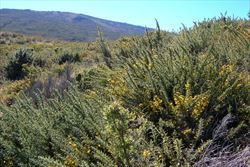
large infestation (Photo: Forest and Kim Starr, USGS)
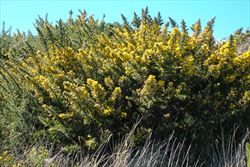
habit (Photo: Forest and Kim Starr, USGS)
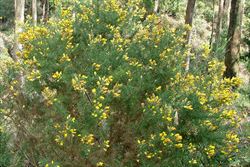
habit (Photo: Sheldon Navie)
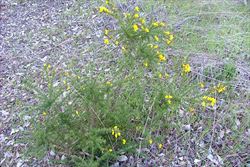
habit (Photo: Sheldon Navie)
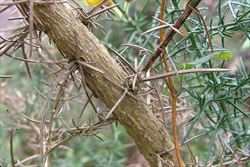
older woody stem (Photo: Sheldon Navie)
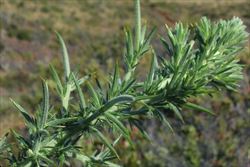
upper leaves reduced to spines (Photo: Forest and Kim Starr, USGS)
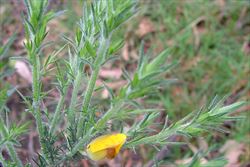
young growth covered in soft hairs (Photo: Sheldon Navie)
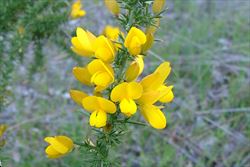
flowers (Photo: Sheldon Navie)
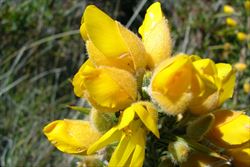
close-up of flower buds with hairy sepals (Photo: Forest and Kim Starr, USGS)
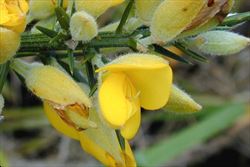
close-up of pea-shaped flower (Photo: Forest and Kim Starr, USGS)
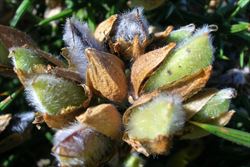
close-up of immature fruit (Photo: Forest and Kim Starr, USGS)
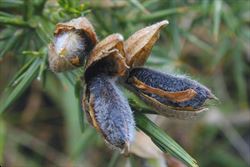
close-up of mature fruit covered in soft hairs (Photo: Forest and Kim Starr, USGS)
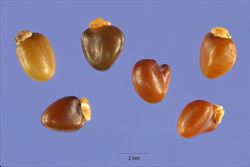
close-up of seeds (Photo: Steve Hurst at USDA PLANTS Database)
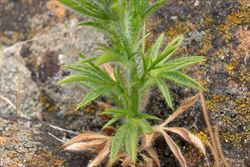
seedling (Photo: Greg Jordan)
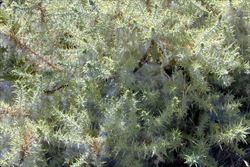
a plant infested with gorse spider mite (Tetranychus lintearius), a successful biological control agent (Photo: Forest and Kim Starr, USGS)
Scientific Name
Ulex europaeus L.
Family
Fabaceae (Queensland, the ACT, Victoria, Tasmania and the Northern Territory)
Fabaceae: sub-family Faboideae (New South Wales)
Leguminosae (South Australia)
Papilionaceae (Western Australia)
Common Names
common gorse, European gorse, furze, golden gorse, gorse, Irish furze, whin
Origin
Native to central and western Europe (i.e. France, Portugal, Spain, Italy, Germany, the Netherlands and Switzerland) and the British Isles.
Naturalised Distribution
Widely naturalised in southern and eastern Australia, particularly in the coastal and sub-coastal districts of south-eastern Australia. It is most abundant and widespread in Tasmania and Victoria, but is also realtively common in the south-eastern parts of New South Wales and South Australia. Also occasionally naturalised in south-western Western Australia, other parts of eastern New South Wales and south-eastern Queensland, and sparingly naturalised in the ACT.
Also naturalised overseas in northern and eastern Europe, northern and southern Africa, temperate and tropical Asia, New Zealand, western and north-eastern USA (i.e. California, Oregon, Washington, Virginia, West Virginia, Pennsylvania, New York and Massachusetts), Hawaii, Central America, South America and the Mascarenes.
Habitat
This species is mainly a weed of hillsides, waterways, roadsides, railways, pastures, grasslands, open woodlands, forests, disturbed sites, coastal environs, waste areas and forest margins in temperate regions. It is also occasionally found in the cooler, upland areas of sub-tropical regions.
Habit
An upright (i.e. erect or ascending), dense (i.e. much-branched), spiny shrub usually growing 60-250 cm tall, but occasionally reaching up to 4 m or more in height. Plants growing in harsh conditions may occasionally be very low-growing (i.e. procumbent), and such plants are capable of producing roots from their stems (i.e. adventitious roots).
Distinguishing Features
- a woody shrub usually growing 0.5-2.5 m tall with spiny stems.
- the 'leaves' are usually reduced to narrow, rigid, dark-green spines (5-35 mm long and about 1.5 mm wide) that are borne in clusters along the branches.
- it produces masses of bright yellow pea-shaped flowers (15-25 mm long).
- these flowers are borne in the leaf forks or in small clusters at the tips of the branches.
- its small egg-shaped or oblong pods (10-25 mm long and 6-8 mm wide) turn dark brown or black in colour as they mature and are densely covered in long spreading hairs.
Seedling
The leaves are alternately arranged and compound, consisting of three small leaflets (i.e. they are trifoliate), when the plant is in the seedling stage.
Stems and Leaves
The branches are ribbed when young, hairy (i.e. pubescent), armed with large spines (up to 50 mm long) and possess many smaller branches (i.e. branchlets) that each end in a sharp spine. These younger stems are green in colour, but as they mature they turn brown, become woody, and develop a deeply-furrowed bark.
On mature plants the 'leaves' are usually reduced to narrow, rigid, dark-green coloured spines (5-35 mm long and about 1.5 mm wide). These 'spine-like leaves' (sometimes called phyllodes) are very numerous, stalkless (i.e. sessile), sometimes hairy (i.e. pubescent), and usually occur in regularly spaced clusters along the branches.
Flowers and Fruit
The numerous, sweet-smelling (i.e. fragrant), flowers are yellow and pea-shaped in appearance (15-20 mm across). These flowers are borne on short stalks (i.e. pedicels) 5-7 mm long, either in the leaf forks (i.e. axils) or in small clusters at the tips of the branches. They have bright yellow petals (15-25 mm long) and a yellowish coloured, membranous, hairy (i.e. pubescent) calyx (10-15 mm long) that is almost divided to the base (i.e. it is two-lipped) and has five teeth. Flowering may occur throughout the year, but is most abundant from late winter to early spring and during autumn in cooler climates and during spring and summer in warmer climates.
The fruit are small egg-shaped (i.e. ovoid) or oblong pods (10-25 mm long and 6-8 mm wide) that turn dark brown, grey or black in colour as they mature. They often have an inflated appearance, and are densely covered in long spreading hairs. Each pod contains 1-6 seeds and is partly hidden by the remains of the flowers (i.e. the calyx bracts). The seeds are smooth and shiny in appearance, olive green or brown in colour, and either kidney-shaped (i.e. reniform), rounded or somewhat triangular in shape (2-4 mm long and about 2.5 mm wide). They also have a small straw-coloured or whitish structure attached to them (i.e. an aril).
Reproduction and Dispersal
This plant generally reproduces via its relatively large seeds, which are spread by several means. Cultivation and movement of the root system occasionally also leads to regeneration from root fragments.
They can be explosively released small distances (i.e. up to 5 m) from their pods when they reach maturity. Animals such as birds and ants may collect the seeds and contribute to their spread. Seeds may also be dispersed in contaminated soil (e.g. during road-making, grading and other soil-moving activities), in mud, by water, and in dumped garden waste.
Environmental Impact
Gorse (Ulex europaeus) is regarded as a significant environmental weed in Victoria, Tasmania, the ACT and South Australia, and as an environmental weed in New South Wales, Western Australia and Queensland. This species is also one of the twenty Weeds of National Significance (WoNS) and is actively managed by community groups in Tasmania, South Australia and Victoria.
It is also listed in the Global Invasive Species Database (GISD), and is regarded to be among the top 100 of the world’s worst invasive alien species.
Legislation
This species is declared under legislation in the following states and territories:
- ACT: C2 - a pest plant that must be suppressed, and C4 - a prohibited pest plant (a pest plant whose propagation and supply is prohibited).
- New South Wales: Class 2 - a regionally prohibited weed. The presence of the weed must be notified to the local control authority and it must be eradicated from the land and the land must be kept free of the plant (in a minority of local authority areas), and Class 3 - a regionally controlled weed. The relevant local control authority must be promptly notified of the presence of this weed and it must be fully and continuously suppressed and destroyed (in a minority of local authority areas). See the New South Wales Department of Primary Industries Noxious Weeds List at http://www.dpi.nsw.gov.au for more detailed information on which local areas are covered in these declarations.
- Northern Territory: A - to be eradicated (throughout the Territory) and C - not to be introduced into the Territory.
- Queensland: Class 1 - introduction into the state is prohibited, and landowners must take reasonable steps to keep land free of this species (throughout the entire state). It is also illegal to sell a declared plant or its seed in this state.
- South Australia: 2@ - this species is regarded as a Class 2c weed or statewide pest plant. Its control is required throughout the entire state, and trade and movement is also restricted throughout the entire state.
- Tasmania: D - the importation or sale of this species is prohibited and measures to reduce its population in an area, eradicate it from an area, or restrict it to a particular area may be required.
- Victoria: P2 - prohibited and must be eradicated or controlled (in the West Gippsland and East Gippsland regions), and C8 - all reasonable steps must be taken to control the weed and prevent its spread (in the Wimmera, Glenelg, North Central, Corangamite, Goulburn, North East, Port Phillip East and port Phillip West regions).
- Western Australia: P1 - trade, sale or movement of this species or its seeds is prohibited (throughout the state), P2 - to be eradicated (throughout the whole of the state, except for the City of Albany, Cranbrook, Denmark and Plantagenet local authority areas), and P3 - this species cannot be eradicated in the short term, but must be kept under 'control' (in the City of Albany, Cranbrook, Denmark and Plantagenet local authority areas). See the Western Australian Department of Agriculture and Food Declared Plant List at http://www.agric.wa.gov.au/ for more detailed information about which areas are covered by these declarations.
Management
For information on the management of this species see the following resources:
- the National Weeds Strategy Strategic Plan for this species, which is available online at http://www.weeds.org.au/WoNS/gorse/docs/gorstrat.pdf.
- the Best Practice Manual for this species, which is available online at http://www.weeds.org.au/WoNS/gorse/.
- the Victorian Department of Primary Industries Landcare Note on this species, which is available online at http://www.dpi.vic.gov.au.
- the Tasmanian Department of Primary Industries and Water weed service sheet on this species, which is available online at http://www.dpiw.tas.gov.au.
- the Western Australian Department of Agriculture and Food Farmnote on this species, which is available online at http://www.agric.wa.gov.au.
Similar Species
Gorse (Ulex europaeus) is very similar to broom (Cytisus scoparius subsp. scoparius), spiny broom (Calicotome spinosa), flax-leaf broom (Genista linifolia), Montpellier broom (Genista monspessulana) and Madeira broom (Genista stenopetala) at a distance, as these are all shrubs that produce masses of yellow pea-shaped flowers. However, these species can be distinguished by the following differences:
- gorse (Ulex europaeus) is spiny (i.e. armed) and the adult plants tend to lack any obvious leaves, instead bearing narrow spine-like 'leaves' in clusters along the stems. Its pods are relatively small (10-25 mm long), oblong or ovoid (i.e. egg-shaped), and densely covered in long hairs.
- broom (Cytisus scoparius subsp. scoparius) is without spines (i.e. unarmed) and has leaves with three small, oval-shaped, leaflets (i.e. trifoliolate leaves) that are 5-20 mm long. Its pods are very large (25-70 mm long), elongated in shape, and only have hairs present along their edges.
- spiny broom (Calicotome spinosa) is spiny (i.e. armed) and has leaves with three small leaflets (i.e. trifoliolate leaves) that are 6-12 mm long. Its pods are relatively large (up to 40 mm long), flattened, hairless, and end in a small spine.
- flax-leaf broom (Genista linifolia) is without spines (i.e. unarmed) and has leaves with three narrow leaflets (i.e. trifoliate leaves) that are 20-30 mm long. Its pods are relatively small (15-30 mm long) and covered in silky or downy hairs.
- Montpellier broom (Genista monspessulana) is without spines (i.e. unarmed) and has leaves with three relatively large, broad, leaflets (i.e. trifoliate leaves) that are 5-30 mm long. Its pods are relatively small (10-25 mm long) and densely covered in silky or downy hairs.
- Madeira broom (Genista stenopetala) is without spines (i.e. unarmed) and has leaves with three relatively large, oval-shaped, leaflets (i.e. trifoliate leaves) that are 8-30 mm long. Its pods are relatively small (25-30 mm long) and densely covered in silky or downy hairs.

